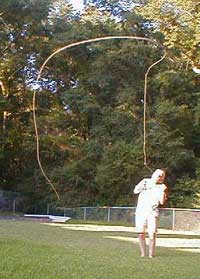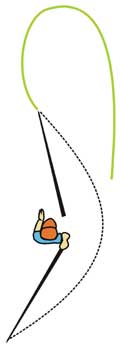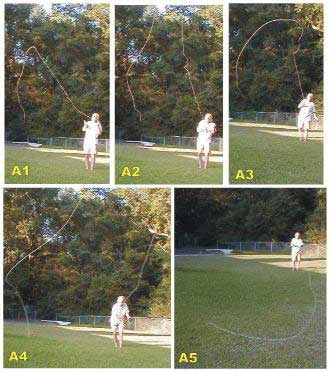The Most Un-Appreciated Fly Cast
For the angler that fishes moving water, the most useful casts are certainly the slack line casts and mends. These casts eliminate drag and help produce the natural drifts that catch fish. High on the list of favorites are the tuck, the reach, the puddle and the parachute. But the cast that's moved to the top of my list is probably the most unappreciated, and is often denigrated to the point of being called useless. Not so, however; once you understand how to make and use the underpowered curve cast, it will catch fish.
 There are numerous ways to throw a curve cast - there's the over-powered curve, the hook curve and the v-curve to name a few. The under-powered curve gets only a brief mention in most casting texts, and is usually written off as inaccurate and undependable. The U-P curve is usually made just by under-powering a conventional side-arm cast; the loop doen't straighten completely and lands on the ground in a curve. The U-P curve is pretty simple and not a very exciting cast at first glance.
There are numerous ways to throw a curve cast - there's the over-powered curve, the hook curve and the v-curve to name a few. The under-powered curve gets only a brief mention in most casting texts, and is usually written off as inaccurate and undependable. The U-P curve is usually made just by under-powering a conventional side-arm cast; the loop doen't straighten completely and lands on the ground in a curve. The U-P curve is pretty simple and not a very exciting cast at first glance.
 Not exciting, that is, until you learn how to control it and how to use it. I prefer to throw the U-P curve with the rod in a more vertical position - more control and more options in presentation. To use a vertical rod, it is necessary to throw the loop off the side of the rod rather than off the tip (see photo above). On the forward cast, the rod is moved from behind the head, then out away from the body, and then back in front of the body at the end of the cast (see illustration at right).Because the line follows the rod tip, this gets the loop off to the side of the rod where it forms and unrolls in a horizontal plane.
Not exciting, that is, until you learn how to control it and how to use it. I prefer to throw the U-P curve with the rod in a more vertical position - more control and more options in presentation. To use a vertical rod, it is necessary to throw the loop off the side of the rod rather than off the tip (see photo above). On the forward cast, the rod is moved from behind the head, then out away from the body, and then back in front of the body at the end of the cast (see illustration at right).Because the line follows the rod tip, this gets the loop off to the side of the rod where it forms and unrolls in a horizontal plane.
To get the U-P curve to happen, just give the cast a little less power than is needed to fully straighten the loop on the forward cast. With the rod in a more vertical position and the loop forming higher and horizontally (A2, A3 & A4 below), it is easy to measure with false casts exactly where the cast is going and how much power is needed.
The power application is much like normal until the later stages of the cast (Photo A4 below), where instead of a power snap or accelerating to a stop the power just fades and allows the loop to collapse into a curve. The rod tip can be dropped here to "stall" the looop and/or line can be shot to widen the curve of the loop.

Obviously, I guess, this cast is good for throwing around obstacles but other casts can give the same effect. Where the under-powered curve really excels is getting slack upstream of your fly in moderate and faster currents, especially when fishing near to straight upstream. Yes, I know you can throw slack upstream with a tuck or puddle cast. But the slack here tends to be at the leader. The hump mend can throw some upstream slack into the line, but it makes a commotion and the slack generally gets thrown right on top of the fish. The U-P curve can position almost any amount of slack upstream of your fly, and position it to the side of your target so that the first thing the fish sees is your fly (not your line).
As far as being inaccurate, that is not a valid criticism. It can be just as accurate as any other cast, but like many others requires a bit of practice. Throwing the cast with a vertical rod rather than a pure side-arm cast significantly enhances control. A strong wind can affect the accuracy of U-P curve cast (as it can any cast), and when it's a headwind the open loop of this cast is a disadvantage in penetrating the wind. But by varying the amount of power early in the casting stroke, the first part of the loop can be thrown tightly to beat the wind (see photo A2) and at the end of the cast the wind can actually help stall the loop. With a headwind, the loop itself can also be thrown right into the water with power - this is not an under-powered curve but it gives the same effect since the loop doesn't straighten before it hits the water.
The under-powered curve can also be thrown to the non-casting side. Just tilt the rod over your head to the opposite side (e.g., to the left for a right-hander) and make that arcing path (shown in drawing, above left) to the other side.
Add the under-powered curve to your bag of tricks - it will fool some fish. Posted by Kent Edmonds. Kent is a freshwater guide in 50 miles southwest of Atlanta and is certified as a casting instructor by the Federation of Fly Fishers. You can reach him through his website - www.flyfishga.com
 There are numerous ways to throw a curve cast - there's the over-powered curve, the hook curve and the v-curve to name a few. The under-powered curve gets only a brief mention in most casting texts, and is usually written off as inaccurate and undependable. The U-P curve is usually made just by under-powering a conventional side-arm cast; the loop doen't straighten completely and lands on the ground in a curve. The U-P curve is pretty simple and not a very exciting cast at first glance.
There are numerous ways to throw a curve cast - there's the over-powered curve, the hook curve and the v-curve to name a few. The under-powered curve gets only a brief mention in most casting texts, and is usually written off as inaccurate and undependable. The U-P curve is usually made just by under-powering a conventional side-arm cast; the loop doen't straighten completely and lands on the ground in a curve. The U-P curve is pretty simple and not a very exciting cast at first glance. Not exciting, that is, until you learn how to control it and how to use it. I prefer to throw the U-P curve with the rod in a more vertical position - more control and more options in presentation. To use a vertical rod, it is necessary to throw the loop off the side of the rod rather than off the tip (see photo above). On the forward cast, the rod is moved from behind the head, then out away from the body, and then back in front of the body at the end of the cast (see illustration at right).Because the line follows the rod tip, this gets the loop off to the side of the rod where it forms and unrolls in a horizontal plane.
Not exciting, that is, until you learn how to control it and how to use it. I prefer to throw the U-P curve with the rod in a more vertical position - more control and more options in presentation. To use a vertical rod, it is necessary to throw the loop off the side of the rod rather than off the tip (see photo above). On the forward cast, the rod is moved from behind the head, then out away from the body, and then back in front of the body at the end of the cast (see illustration at right).Because the line follows the rod tip, this gets the loop off to the side of the rod where it forms and unrolls in a horizontal plane.To get the U-P curve to happen, just give the cast a little less power than is needed to fully straighten the loop on the forward cast. With the rod in a more vertical position and the loop forming higher and horizontally (A2, A3 & A4 below), it is easy to measure with false casts exactly where the cast is going and how much power is needed.
The power application is much like normal until the later stages of the cast (Photo A4 below), where instead of a power snap or accelerating to a stop the power just fades and allows the loop to collapse into a curve. The rod tip can be dropped here to "stall" the looop and/or line can be shot to widen the curve of the loop.

Obviously, I guess, this cast is good for throwing around obstacles but other casts can give the same effect. Where the under-powered curve really excels is getting slack upstream of your fly in moderate and faster currents, especially when fishing near to straight upstream. Yes, I know you can throw slack upstream with a tuck or puddle cast. But the slack here tends to be at the leader. The hump mend can throw some upstream slack into the line, but it makes a commotion and the slack generally gets thrown right on top of the fish. The U-P curve can position almost any amount of slack upstream of your fly, and position it to the side of your target so that the first thing the fish sees is your fly (not your line).
As far as being inaccurate, that is not a valid criticism. It can be just as accurate as any other cast, but like many others requires a bit of practice. Throwing the cast with a vertical rod rather than a pure side-arm cast significantly enhances control. A strong wind can affect the accuracy of U-P curve cast (as it can any cast), and when it's a headwind the open loop of this cast is a disadvantage in penetrating the wind. But by varying the amount of power early in the casting stroke, the first part of the loop can be thrown tightly to beat the wind (see photo A2) and at the end of the cast the wind can actually help stall the loop. With a headwind, the loop itself can also be thrown right into the water with power - this is not an under-powered curve but it gives the same effect since the loop doesn't straighten before it hits the water.
The under-powered curve can also be thrown to the non-casting side. Just tilt the rod over your head to the opposite side (e.g., to the left for a right-hander) and make that arcing path (shown in drawing, above left) to the other side.
Add the under-powered curve to your bag of tricks - it will fool some fish. Posted by Kent Edmonds. Kent is a freshwater guide in 50 miles southwest of Atlanta and is certified as a casting instructor by the Federation of Fly Fishers. You can reach him through his website - www.flyfishga.com


0 Comments:
Post a Comment
Links to this post:
Create a Link
<< Home